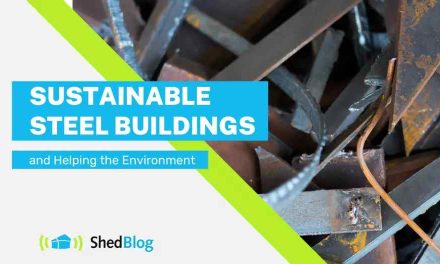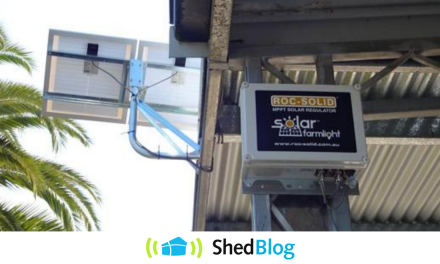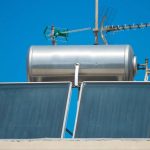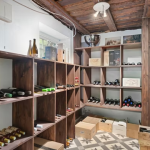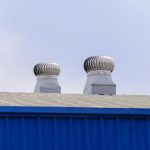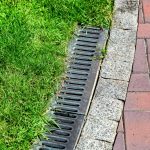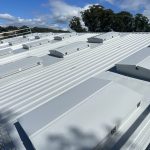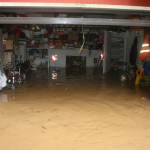5 Simple Upgrades to Make Your Commercial Shed More Energy-Efficient

Enhancing your commercial shed’s energy efficiency is easier than you might think. Small, targeted upgrades can lower energy bills, improve comfort, and create a more sustainable workspace without a full overhaul.
Improve Insulation for Immediate Results
Upgrading the insulation in your commercial shed can significantly enhance energy efficiency. By focusing on high-quality materials for walls and the roof, sealing off any potential air leaks, and opting for insulated roller doors, you quickly cut down on energy costs and maintain a better temperature inside.
Upgrade Walls and Roof With High-Quality Insulation
Investing in top-notch insulation for the walls and roof is crucial. Look for materials like spray foam or rigid foam boards, which offer excellent thermal resistance. Not only do they keep temperatures stable, but they also help reduce energy consumption.
For retrofits, select materials that are easy to install and offer a high R-value to maximise insulation performance and energy savings.
Seal Doors and Windows to Minimise Air Leaks
Air leaks can make a significant dent in your energy efficiency. Check around doors and windows for drafts. Weather-stripping and caulking are effective methods to seal these gaps. Self-adhesive foam tape works well for doors and window frames.
Doing so locks in warmth during colder months and keeps things cooler when it’s warm. Invest a little time to ensure every opening is well-sealed. Reduced drafts lead to noticeable energy savings.
Install Insulated Roller Doors
For large openings in your shed, insulated roller doors are an ideal solution. Unlike regular doors, these come with layers of insulation that prevent heat transfer. Choose doors with good weather seals to further enhance efficiency.
Insulated roller doors also offer an added benefit of noise reduction, making the shed a more pleasant place to work in. With a variety of options in terms of thickness and materials, you can select a door that best fits your budget and insulation needs.
Enhance Lighting to Save Energy and Boost Comfort
Improving the lighting in your commercial shed not only cuts energy costs but also creates a more pleasant environment. By opting for efficient lighting solutions and utilising natural light, you can enhance productivity and reduce your energy bill.
Switch to LED Fixtures Throughout the Shed
LED fixtures are a game-changer for energy efficiency. Swapping out traditional bulbs for LEDs can reduce electricity usage significantly, as they use up to 80% less energy. LED lighting solutions also have a longer lifespan, meaning fewer replacements and maintenance.
LEDs offer different color temperatures. Choose warmer tones for a more inviting atmosphere or cooler tones for task-oriented areas. This flexibility ensures you provide optimal lighting for different tasks. Plus, LEDs emit less heat, reducing cooling needs in the warmer months.
Add Skylights or Light Tubes for Natural Daylighting
Natural daylight can transform your shed. Installing skylights or light tubes is an effective way to flood the space with sunlight, reducing the need for artificial light during the day. Learn more about energy-efficient shed upgrades on ShedBlog. They can be strategically placed to illuminate the most frequently used areas.
Skylights offer broad light coverage, while light tubes are ideal for smaller spaces. When choosing these, consider their placement, potential heat gain, and ventilation options. Energy-efficient designs are available to minimise heat transfer, making them suitable for any climate.
Integrate Lighting Sensors or Timers
Automating your lighting with sensors or timers conserves energy effortlessly. Motion sensors are perfect for areas not constantly in use, ensuring lights are only on when needed. This reduces wasted energy and prolongs the life of your light fixtures.
Timers maintain a consistent schedule, switching lights off during daylight or when the shed is unoccupied. This hands-off approach saves energy with minimal effort.
Optimise Heating, Cooling, and Ventilation Systems
To reduce energy consumption in your commercial shed, focus on upgrading your HVAC and ventilation systems. By selecting high-efficiency units and utilising smart controls, you can enhance performance and lower operating costs, according to a recent energy efficiency study. Incorporating fans also boosts airflow, contributing to a more comfortable environment.
Upgrade to Energy-Efficient HVAC Units
Selecting energy-efficient HVAC units is crucial for reducing power usage and costs. When exploring options, choose models that offer high efficiency throughout the cooling season, helping to reduce energy use and costs. These units use less electricity and can cut down on utility bills significantly. Additionally, look for systems that offer variable speed settings, allowing for more precise control of heating and cooling needs.
Ensure the system size matches the shed’s requirements, as correctly sized units run more efficiently. Regular maintenance, including filter changes and inspections, keeps it running smoothly.
Install Programmable Thermostats
Adding programmable thermostats provides better control over your shed’s climate. With these devices, you can set specific temperatures for different times of the day. This ensures that heating or cooling is activated only when necessary, reducing waste.
Some thermostats are now Wi-Fi enabled, letting you adjust settings remotely. This flexibility is helpful for maintaining an optimal environment, especially if the shed is not constantly occupied. Learning features on some models adapt to patterns, optimising further.
Effortless to install and user-friendly, programmable thermostats are a practical way to upgrade your energy management. Selecting units compatible with your existing HVAC system is key.
Add Ceiling or Exhaust Fans for Better Airflow
Introducing ceiling or exhaust fans can significantly improve air circulation, enhancing comfort without overloading the HVAC system. Ceiling fans create a breeze that makes spaces feel cooler in warm weather, reducing reliance on air conditioning. In colder months, reverse the fan’s direction to push warm air downward.
Exhaust fans are useful for removing hot air, moisture, and pollutants. Place them strategically in areas prone to high heat or humidity. Look for models with adjustable speeds to tailor performance to your needs.
Fans are a low-cost investment that improves airflow and energy efficiency. Regular cleaning maintains performance. Additionally, businesses in South Australia can take advantage of the fridge rebate by investing in energy-efficient fridges and freezers, which further reduces electricity costs and complements these upgrades.
Adopt Smart Energy Management Solutions
Adopting smart energy management solutions can significantly increase energy efficiency in your commercial shed. By incorporating technologies like smart meters, automation systems, and renewable energy, you can effectively manage and reduce energy consumption.
Integrate Renewable Energy Sources Like Solar Panels
Integrating renewable energy, such as solar panels, into your energy management plan offers sustainable benefits. Solar panels take advantage of sunlight to generate electricity, which can significantly reduce dependency on conventional power sources. Tax incentives and rebates are often available, making solar panels a more affordable option. These renewable sources not only contribute to a reduction in energy costs but also lessen environmental impact. As energy needs to grow, the capacity to expand your renewable energy installation provides additional flexibility. By optimising solar energy storage and usage, you can maintain efficient operations, even during peak times.
Monitor Energy Usage With Smart Meters
Smart meters provide real-time data on energy use, helping identify areas for improvement. Visual dashboards make patterns easy to see, guiding energy-saving strategies and reducing both costs and carbon footprint. Smart meters can often be integrated into a broader energy management system, offering seamless monitoring and control across various types of equipment or machinery.
Automate Equipment Shutdowns
Automating equipment shutdowns can prevent unnecessary energy usage during non-operational hours. With programmable systems, you can set specific times for machinery to power down. This ensures that no equipment runs longer than necessary. Consider using timers and sensors as part of your automated shutdown plans. These tools work together to stop energy waste, ultimately leading to noticeable savings on your utility bills. Additionally, automation minimises human error, providing a more reliable and consistent approach to energy management. This not only boosts efficiency but also extends the lifespan of your equipment, as less wear and tear occurs.
Conclusion
By implementing these simple upgrades—improving insulation, sealing openings, enhancing lighting, optimising HVAC systems, and adopting smart energy management—your commercial shed can become significantly more energy-efficient, reduce operating costs, and provide a comfortable, sustainable workspace, all while contributing to a greener future.

